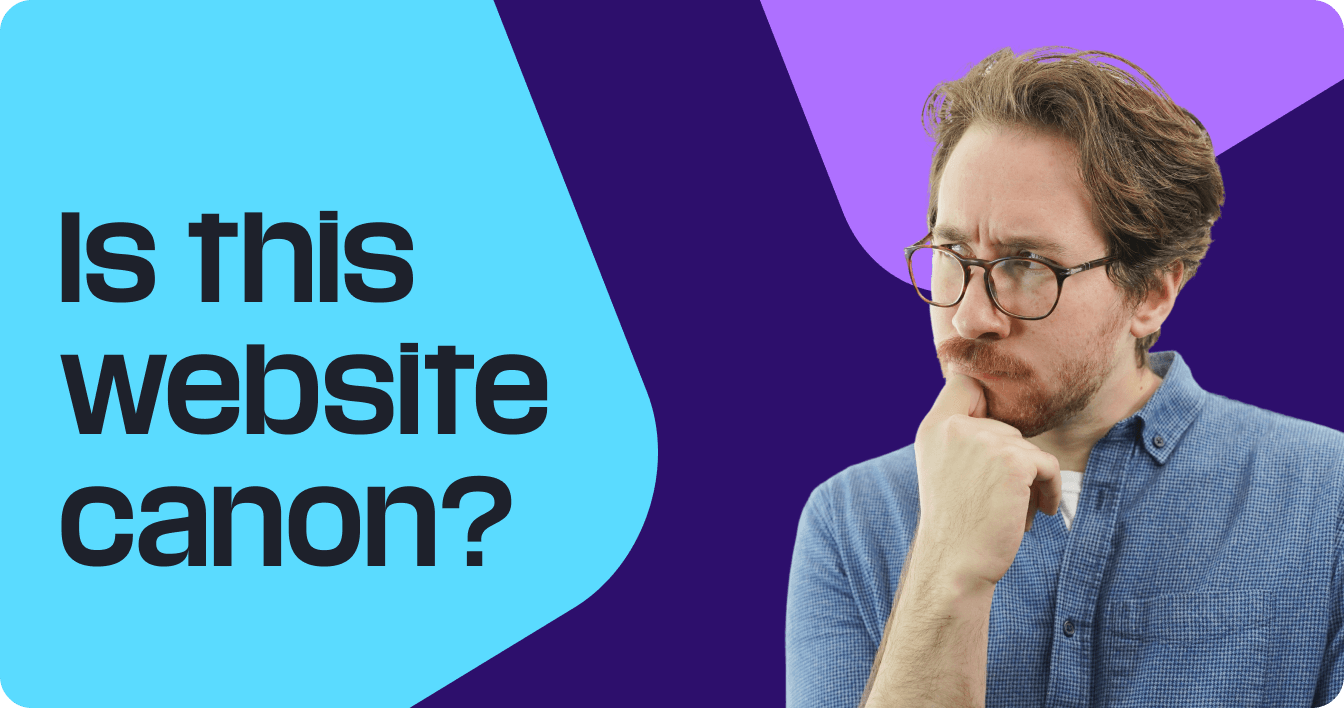Explore one of the most important aspects of search engine optimization (SEO): Canonical URLs. Learn the definition of canonical URLs, why they matter, and how to use them in your SEO strategy!
What is a canonical URL?
A canonical URL is a web address that indicates the master page when there are duplicate pages on a website. Search engines like Google will determine and set the canonical URLs to prevent repeated pages from being shown in search results.
What is a canonical tag?
A canonical tag is a snippet of HTML coding that enables you to determine the “main” page of content within a set of duplicate content. This tag tells Google which version of the page to index, so that page maintains all the link equity. The code appears as follows:<link rel="canonical" href="yourwebsiteURLhere.com/" />
Why should I use canonical tags?

“There are a number of reasons why you would want to explicitly tell Google about a canonical page in a set of duplicate or similar pages:
- To specify which URL that you want people to see in search results.
- To consolidate signals for similar or duplicate pages.
- To simplify tracking metrics for a piece of content.
- To avoid spending crawling time on duplicate pages.”
The big question surrounding canonical URLs is “why should I use them?” The answer: Duplicate content.
Duplicate content is two or more pages of content that have similar or exact copies of information. It’s not just limited to your own website either — someone could take content from your website and post it on their own, making it duplicate content.
So, what’s the issue with this?
Duplicate content negatively impacts your ranking in search results. Instead of all the value and link equity going to one page, it goes to multiple pages and gets diluted. You would have multiple pages competing against each other for the same keywords, leading to keyword cannibalization.
Keyword cannibalization is when you have different pages targeting the same keywords, which leads them to compete with each other.
If you were trying to outrank a competitor, you wouldn’t have enough link equity in one page to outrank them because it’s spread out on multiple pages that are battling each other for rankings.
Additionally, you may not want to remove the duplicate page outright because it may have some value to it. Instead of losing that value, you can transfer it to the main page.
Without canonicalization, you also risk consequences, like:
- Less organic traffic coming to your website
- Fewer pages getting indexed (which means people won’t see your pages in search results)
- Penalties (Very rare — typically only for websites that purposely copy content from another website)
That’s why canonicalization in SEO is so crucial. Having a canonical link to one page puts all the value on that page, so it can rank better in search results.
4 best practices for using canonical URLs
Ready to implement canonical tags into your website? Here are four best practices for integrating a canonical link into your site:
1. Use Google Search Console to identify duplicate content
Before you can implement a canonical tag into your website, you need to identify where you have duplicate content on your site. The easiest way to do that is to use Google Search Console to help you find it.
Google Search Console has a duplicate content feature that will scrape your website looking for duplicate pages. Using this tool will give you a starting point to understand where you need to implement a canonical tag.
2. Use only one canonical URL per page
When you identify the pages that need a canonical tag, make sure you only use one canonical URL for each page. If you try to use multiple canonical tags on a page, you’ll confuse Google, and it won’t know which one to follow.
3. Use your website’s full URL in the canonical tag
To do canonicalization in SEO successfully, you need to use your website’s full URL in the canonical tag –– this is called the absolute URL.
An absolute URL looks like this:
https://www.baking.com/cupcake-recipes/
When inserted into your canonical tag, it appears like this:
<link rel="canonical" href="https://www.baking.com/cupcake-recipes" />
You need to use the full, absolute URL, rather than a relative URL. A relative URL would just be the backend of the website URL –– for this example, it would just be “/cupcake-recipes/.” It won’t work if you use a relative URL, so make sure you input the entire address in your canonical tag.
4. Pay attention to the small details of your canonical URL
A crucial component of canonicalization in SEO is paying attention to the small details. There are a lot of nuances within your URL that you’ll want to double check, so the right page gets indexed.
Here are some areas you’ll want to look at:
Domain protocol
When you create your canonical tag, make sure you use the correct domain protocol within your URL.
One of the duplicate content issues Google Search Console can identify is having pages with two different domain protocols –– HTTP and HTTPS. So, when you create your URL, you must ensure you use the correct domain protocol to get the right page indexed.
Generally, you’ll use the HTTPS protocol within your canonical URL if you have it on your website.
Trailing slash
When you input your URL into your canonical tag, check to see if it has a trailing slash. Here’s a comparison:
- Non-trailing slash: Your website URL looks like “baking.com/cupcake-recipes”
- Trailing slash: Your website URL looks like “baking.com/cupcake-recipes/”
Pay attention to whether the master page has the trailing slash, so you can direct Google to index the right page.
Web address
When you look at your canonical URL, make sure you use the correct version of your web address. Some websites use a “WWW.,” while others omit it entirely. Here’s how they look different:
- With the WWW: https://www.baking.com/cupcake-recipes/
- Without the WWW: https://baking.com/cupcake-recipes/
You want to be consistent about this throughout your website, so choose one format and stick with it throughout your canonical URLs.
Learn more about how to optimize your website for search engines
Want to learn more about topics like canonicalization in SEO? Check out our SEO glossary and blog to learn more about SEO best practices, tips, and more!
Don’t fail your website’s most important test
Get an SEO scorecard of your website for free in less than 30 seconds.
Writers

Related Resources
- What is a 301 Redirect? When & How to Use Them
- What is a 302 Redirect? Comparing 302 vs. 301 Redirects
- What is a 404 Error? Overview and How to Fix It
- What is a Cached Page? A Beginner’s Guide to Cached Web Pages in SEO
- What is a CMS? Your Guide to Content Management Systems
- What is a Noindex Tag? A Beginner’s Guide to Noindex in SEO
- What is a Search Crawler? Your Ultimate Guide to Search Bots
- What is a SERP (Search Engine Results Page)?
- What is a Sitemap? Definition, Uses, and Tips
- What is Black-Hat SEO? Definition, Techniques, and Why to Avoid It


